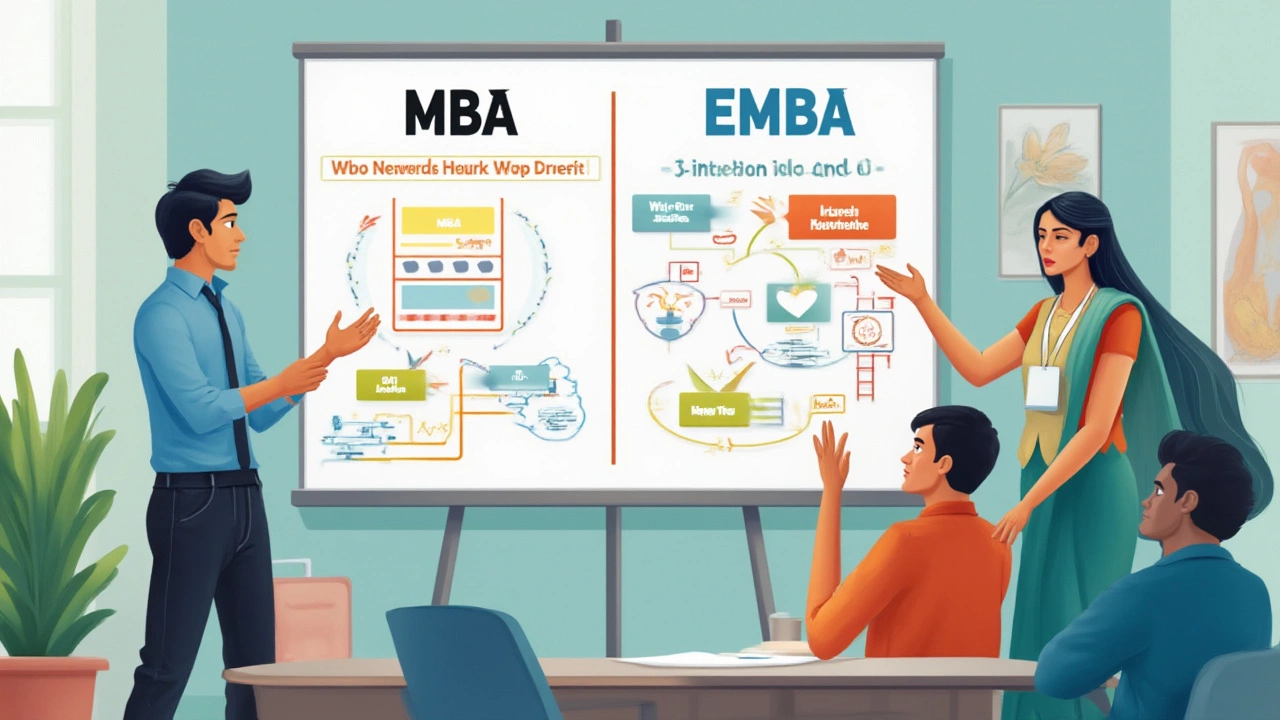Blame it on business buzzwords or just the sheer number of choices, but picking between an EMBA and a regular MBA can feel like trying to decode a secret menu. People often mix them up, thinking they're the same old business degree with a slightly fancier name. Actually, they each take you on totally different rides. The only thing worse than forking over thousands for the wrong program? Spending years in the wrong one. So, how do you dodge the trap and actually match your ambition, schedule, and experience with the right degree?
What Exactly Is an MBA? And What Makes an EMBA Different?
The traditional MBA — Master of Business Administration — is like the gold standard for business education. It's the degree most people picture when they hear someone wants to "go to business school." Full-time MBA programs usually take about two years to finish, but accelerated, part-time, and online variations have popped up in the past decade. You’ll cover accounting, finance, marketing, operations, strategy, and leadership, and often pick a specialization. Along the way, there’s group work, networking, internships, and sometimes overseas trips. Most full-time students are in their mid-to-late twenties, with two to five years of experience under their belt. It’s a step up for those looking to leapfrog from entry-level roles to management, change careers, or launch something new.
Now, the EMBA — or Executive MBA — isn’t just a souped-up version. It’s targeted squarely at seasoned professionals, folks who’ve been managing people, projects, or departments for years. The average EMBA student is usually somewhere between 35 and 45—with upwards of ten, sometimes even 15 years, of career action behind them. Classes happen on weekends or evenings to keep things work-friendly. What sets it apart isn’t just timing or age—it’s how problems are tackled. Instead of looking at theoretical case studies, a lot of EMBA programs ask students to bring real-life work issues into the classroom, using peer experience to shape solutions. You won’t find recruiters prowling the halls the same way you might in a regular MBA; most EMBA students are there because they want to earn a seat in the C-suite at their current company, or polish up before starting their own venture.
Here’s a quick look at the usual profile of students in each program:
| MBA | EMBA | |
|---|---|---|
| Average Age | 27–30 | 37–40 |
| Work Experience | 2–5 years | 10–15 years |
| Typical Schedule | Full-time/part-time/online | Weekend, modular, evenings |
| Recruiting Focus | Job search, internships, career change | Career advancement within current path |
So, don’t fall into the age trap—if you’re early- to mid-career and want to hustle for a completely new job or climb up a level fast, the MBA is built for you. But if you’re already steering teams or juggling budgets, and want to push yourself into the upper echelons without hitting pause on your job, the EMBA might be your game-changer.
Who Should Choose an MBA vs an EMBA: Profiles, Motivations, and Outcomes
Now that you get the age and experience split, let’s dig deeper into why people pick each path — and what they actually get out of it. MBAs are the classic career switchers’ ticket. Tons of people go in with the intention to break into consulting, banking, tech, or even areas like healthcare management that weren’t on their radar before. They’re looking to build a new network, beef up their management skills, and stand out in a pile of resumes. Campus activities, incubators, clubs, and lead roles in student bodies also play a big part in the broader MBA experience. If you crave that “college 2.0” vibe and want to land those big-name internships, you’re in the right camp.
Most EMBA students are in a different headspace. They’re not quitting their jobs to study, and honestly, they’d lose ground if they tried. They want practical tools to help solve the challenges they’re already facing at work — think: leading a merger, entering new markets, or boosting team performance. They lean into lessons plugged straight into their companies, and reports actually show about 53% of EMBA students get a promotion or increase in job responsibilities during or shortly after finishing their program (Executive MBA Council, 2024 Annual Survey). No surprise, many EMBA cohorts stick together long after graduation. It's not rare to see lifelong business collaborations start with class projects or weekend debates.
Let’s get concrete. If you’re hungry to:
- Change your career field completely
- Access internship opportunities
- Move geographically for a fresh start
- Leverage on-campus recruiting for leading firms
- Create a new professional network from scratch
...the MBA probably checks your boxes. But, if your ambitions sound more like:
- Dive deeper into your industry and level up
- Get promoted where you already work
- Master straight-up leadership skills
- Apply learning to real-world business challenges immediately
- Study without sacrificing your current salary
...the EMBA is built for your needs.
One thing people rarely mention—employers often pay all or part of EMBA tuition if you can show clear business value for your new skills. For MBAs, scholarships and loans are the norm, but company sponsorship isn’t as common because you’re likely to be job-hunting as soon as you graduate.

Curriculum, Format, and Lifestyle: What Your Day-to-Day Really Looks Like
Let’s talk about what actually happens when you start either program. In a traditional MBA, you should expect a full course load: approximately 12–18 months for fast-track programs or the typical two-year slog. First year is usually about foundations, covering finance, accounting, marketing, leadership, operations, and strategy. Most programs make you work 10–15 hours a week on group projects alone, not counting lectures, assignments, and networking events. If you take the plunge as a full-timer, your days look a lot like college. Evenings — especially in cities like New York, Chicago, or London — are packed with guest lectures, happy hours, and student club meetings.
EMBA students have to juggle work, life, and school, which means programs work around their schedules. Weekend classes, Friday–Saturday modules, or even a few intense week-long residencies are the norm, with lots of reading and team calls in between. Don’t expect long summer breaks — classes often run year-round with shorter breaks. Group assignments are alive and well, but now you’re often paired with peers who’ve handled million-dollar deals or managed global teams. Sometimes, you’ll present your company’s strategic plan to classmates who’ll seriously challenge it from their own industries’ viewpoints. There’s little hand-holding. Most folks come prepared to put in extra nights and squeeze in reading on flights or lunch breaks.
MBA life is immersive, sometimes even a little “bubble”-like. Many students form tight social circles, and campus events are a launchpad for lifelong friendships. The EMBA life is more about balancing priorities. That soccer game you promised to catch with your kid? It’ll probably collide with a team Zoom call or a case study review — but your classmates are dealing with the same tug-of-war.
Here are some typical weekly patterns:
| MBA (Full-Time) | EMBA | |
|---|---|---|
| Class Hours | 15–20 | 8–10 |
| Group Work | 10–18 | 6–10 |
| Networking Events | 4–8 | 2–3 |
Ready for a pro tip? If you thrive on structure and university life, an MBA will feel familiar. But if you want business school without stepping away from your career — and you like the idea of learning from equally experienced classmates — the EMBA is built for you.
Admissions and Costs: What It Takes to Get In and Pay Up
No one likes jumping through hoops, but these programs don’t hand out seats as party favors. The MBA admissions process is famously competitive. Applicants need solid undergrad GPAs, competitive GMAT or GRE scores, letters of recommendation, essays, a resume, sometimes even video interviews or assessment days. The top schools — think Harvard, Stanford, or INSEAD — are looking for high test scores, leadership stories, sharp analytical minds, and clear purpose. Work experience doesn’t have to be superstar-level, but showing momentum matters — promotions, increased responsibilities, maybe a side project or some volunteering. International experience is a huge plus. Acceptance rates for top-10 MBA programs hover around 8–14% as of 2024.
EMBA admissions skip the test scores at some schools (though many still request them). Applicants must show years of progressive experience — the resume should show a story of career growth, not just time served. Letters from your employer are often required, sometimes authorizing time off or financial support. Recommendations need to nail down leadership skill, ambition, and the ability to contribute at a senior level. Some programs demand employer interviews or company support certificates. Fewer spots are available in each class — typically 40–100 instead of 200–400 at most MBAs. So while fewer people apply, competition is still stiff.
Now, about that price tag. The average EMBA vs MBA tuition cost was approximately $106,000 (USD) for MBAs and $120,000 for EMBAs in 2024 (U.S. News data), but these numbers swing fast with exchange rates and living costs, especially outside the U.S. MBAs might stretch expenses with living costs, lost earnings, and fees for extracurriculars. EMBA students keep getting their salaries, but wear another hat of time stress — every missed meeting at work can hit harder than a skipped class for a full-time student. Meanwhile, some employers are still picking up the tab for EMBAs, at least partially. The median employer sponsorship for U.S. EMBA programs in 2024 covered about 40% of tuition, so don't forget to ask.

Career Impact, ROI, and Future Trends
So what’s at the end of the tunnel? If you’re asking, “Is the money and time worth it?” — you’re not alone. MBA programs have, for decades, been the go-to route for jumping into consulting, finance, big tech, real estate, and entrepreneurship. In 2024, the median starting base salary for MBA grads at top-tier U.S. schools was $155,000, with signing bonuses pushing that number higher. Career placement services are a big draw, especially at the full-time level. Graduates can expect to make back the cost of tuition in two to five years, depending on the industry and initial salary.
But the world’s changing. Job markets are more competitive. Automation and AI are shaking things up. MBA programs respond with bigger focuses on tech, analytics, and entrepreneurship than ever before. At the same time, remote work has made the part-time and online MBA — and even hybrid EMBA — more attractive for people who don’t want or need a physical campus to network.
EMBA grads typically don’t see as dramatic a shift in role — big jumps come from internal promotions, expanded responsibilities, or board-level nods. According to the 2024 Executive MBA Council report, 91% of EMBA graduates saw increased responsibilities, and 41% reported a significant salary increase during or within a year of finishing their degree. Graduates often stay within their organizations or industries, but the leap — in pay, scope, and job title — can be huge, especially at global firms.
Curious about top schools? Think: Wharton, Booth, Kellogg, Columbia, and INSEAD for EMBA, versus Harvard, Stanford, London Business School, and HEC Paris for MBA. Each school posts detailed job reports and class statistics — worth scoping out to see real outcomes and who’s actually sitting in those seats.
Final tip: Figure out where you want your degree to take you. The right choice — EMBA or MBA — rests on your experience, goals, company support, and even family schedule. Both degrees hand you lifelong networks, access to top-tier faculty, and a fresh approach to business problems. But you decide: are you pressing restart or fast-forward?

